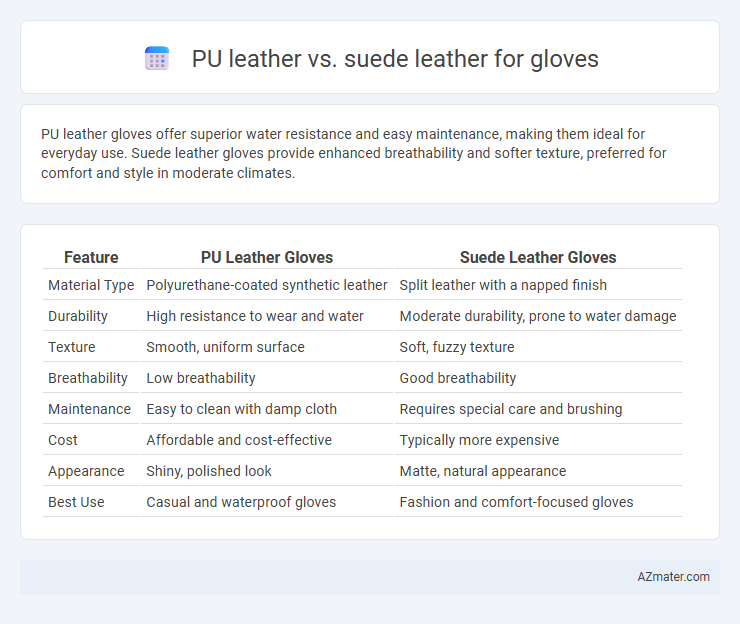PU leather gloves offer superior water resistance and easy maintenance, making them ideal for everyday use. Suede leather gloves provide enhanced breathability and softer texture, preferred for comfort and style in moderate climates.
Table of Comparison
| Feature | PU Leather Gloves | Suede Leather Gloves |
|---|---|---|
| Material Type | Polyurethane-coated synthetic leather | Split leather with a napped finish |
| Durability | High resistance to wear and water | Moderate durability, prone to water damage |
| Texture | Smooth, uniform surface | Soft, fuzzy texture |
| Breathability | Low breathability | Good breathability |
| Maintenance | Easy to clean with damp cloth | Requires special care and brushing |
| Cost | Affordable and cost-effective | Typically more expensive |
| Appearance | Shiny, polished look | Matte, natural appearance |
| Best Use | Casual and waterproof gloves | Fashion and comfort-focused gloves |
Introduction to PU Leather and Suede Leather
PU leather, a synthetic material made from polyurethane, offers durability, water resistance, and an affordable alternative to genuine leather. Suede leather, derived from the underside of animal hides, features a soft, napped finish known for breathability and flexibility but requires more delicate care. Both materials provide distinct tactile experiences and performance characteristics ideal for various glove applications.
Material Composition and Manufacturing Process
PU leather gloves are made from a synthetic polymer layer bonded to a fabric backing, offering water resistance and durability through a manufacturing process involving polyurethane coating and embossing. Suede leather gloves originate from the underside of animal hides, primarily cowhide or lambskin, produced by buffing the inner split leather to achieve a soft, napped finish with enhanced breathability. The manufacturing process for suede involves sanding and treating the leather to create a textured surface, whereas PU leather relies on chemical processes to mimic natural leather's appearance while maintaining cost efficiency and easier maintenance.
Appearance and Aesthetic Differences
PU leather gloves exhibit a smooth, uniform surface with a glossy or matte finish, offering a sleek and modern appearance that mimics genuine leather. Suede leather gloves feature a soft, napped texture with a matte, velvety look, providing a more natural, rustic, and luxurious aesthetic. The contrasting finishes impact the glove's visual appeal, with PU leather favoring a polished, contemporary style while suede emphasizes warmth and depth in design.
Comfort and Fit for Gloves
PU leather gloves offer a smooth, flexible texture that provides a snug fit and excellent comfort for prolonged use, with enhanced breathability and moisture resistance compared to suede. Suede leather gloves feature a soft, velvety surface that molds naturally to the hand, delivering superior comfort and a relaxed fit but may lack the water resistance and durability of PU leather. Choosing between PU leather and suede for gloves depends on prioritizing the balance between fit precision, tactile comfort, and environmental durability.
Durability and Longevity Comparison
PU leather gloves offer exceptional durability due to their synthetic composition, making them resistant to water, stains, and daily wear. Suede leather gloves, while softer and more breathable, tend to show signs of wear and aging faster, particularly in high-friction areas. For longevity, PU leather maintains its structure and appearance over extended use, whereas suede requires more careful maintenance to prevent damage and preserve its texture.
Breathability and Moisture Resistance
PU leather gloves offer superior moisture resistance due to their synthetic coating that prevents water absorption, making them ideal for wet environments. Suede leather gloves provide enhanced breathability as their open, fibrous surface allows better air circulation, reducing sweat buildup during prolonged use. When choosing between the two, PU leather excels in water repellency, while suede leather delivers greater comfort through improved airflow.
Maintenance and Cleaning Requirements
PU leather gloves require simple maintenance involving regular wiping with a damp cloth and occasional use of mild soap to remove dirt, making them resistant to stains and water damage. Suede leather gloves demand more delicate care, including brushing with a suede brush to remove dirt and avoiding moisture exposure to prevent stains and texture damage. Proper storage in a dry place is essential for both materials to maintain glove shape and longevity.
Environmental Impact and Sustainability
PU leather, made from synthetic polymers like polyurethane, has a lower direct animal impact compared to suede leather, which derives from animal hides and involves environmentally intensive livestock farming. However, the production of PU leather releases microplastics and involves petrochemical processes that contribute to pollution and non-biodegradability issues. Suede leather, while biodegradable, demands significant water, land, and chemical use during tanning, raising concerns about deforestation, water pollution, and greenhouse gas emissions in its lifecycle.
Cost and Value for Money
PU leather gloves offer a budget-friendly alternative with durability and easy maintenance, making them ideal for cost-conscious buyers. Suede leather gloves, although pricier, provide superior softness, breathability, and a premium feel, delivering enhanced comfort and style. Evaluating cost and value for money depends on prioritizing affordability versus long-term comfort and luxury.
Choosing the Right Leather for Your Gloves
PU leather offers superior water resistance and durability, making it ideal for gloves used in wet or rugged environments, while suede leather provides enhanced breathability and a soft texture perfect for comfort in cooler, dry conditions. Consider PU leather gloves for tasks requiring easy maintenance and strong wear resistance, whereas suede gloves excel in providing a luxurious feel and better grip control. Selecting the right leather depends on balancing environmental exposure, desired flexibility, and the glove's intended use for optimal performance.

Infographic: PU leather vs Suede leather for Glove
 azmater.com
azmater.com